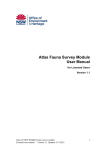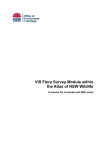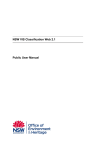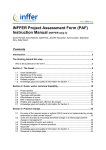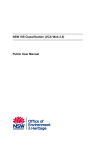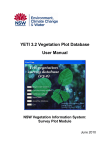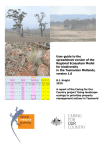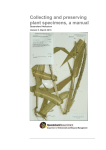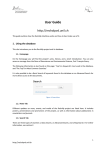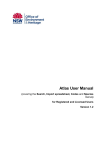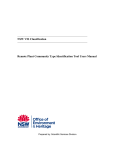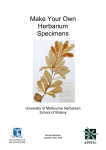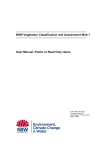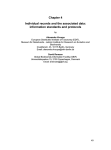Download VIS flora survey public user manual
Transcript
Public User Manual for the VIS Flora Survey module within the Atlas of NSW Wildlife © Copyright State of NSW and the Office of Environment and Heritage, Department of Premier and Cabinet. With the exception of photographs, the Office of Environment and Heritage NSW and State of NSW are pleased to allow this material to be reproduced in whole or in part for educational and non-commercial use, provided the meaning is unchanged and its source, publisher and authorship are acknowledged. Specific permission is required for the reproduction of photographs. The Office of Environment and Heritage NSW (OEH) has compiled this handbook in good faith, exercising all due care and attention. No representation is made about the accuracy, completeness or suitability of the information in this publication for any particular purpose. OEH shall not be liable for any damage which may occur to any person or organisation taking action or not on the basis of this publication. Readers should seek appropriate advice when applying the information to their specific needs. Published by: Office of Environment and Heritage NSW 59–61 Goulburn Street PO Box A290 Sydney South 1232 Report pollution and environmental incidents Environment Line: 131 555 (NSW only) or [email protected] See also www.environment.nsw.gov.au Phone: (02) 9995 5000 (switchboard) Phone: 131 555 (environment information and publications requests) Phone: 1300 361 967 (national parks, climate change and energy efficiency information and publications requests) Fax: (02) 9995 5999 TTY: (02) 9211 4723 Email: [email protected] Website: www.environment.nsw.gov.au ISBN 978 1 74293 355 9 OEH 2011/0766 Last updated: 11th November 2011 Contents 1. Introduction 1 2. Background 1 2.1 What is the VIS flora survey module? 1 2.2 Governance and accountabilities 1 2.3 Structure of the data stored in the module 1 2.4 Limitations of the data 2 2.5 Access to data in the VIS flora survey module 3 2.5.1 2.5.2 Sensitive Species Data Policy (SSDP) and the Government Information (Public Access) Act 3 Restrictions on release of personal information 3 2.6 General user (‘Public view’) 3 2.7 Contributing data 4 3. Getting started 4 3.1 Common Screens within VIS flora survey 5 4. Searching the VIS flora survey module 8 4.1 Survey searches 4.2 Site searches 4.2.1 Flora survey site page 4.3 Replicate searches 4.3.1 Replicate page 8 10 11 16 17 4.4 Referencing VIS flora survey data 24 5. Exiting the VIS flora survey module 24 Glossary 25 List of figures Figure 1: NSW BioNet homepage 4 Figure 2: VIS flora survey page 5 Figure 3: Flora survey page 6 Figure 4: Flora survey site page 7 Figure 5: The replicate page 8 Figure 7: Site search radio button on the VIS flora survey page. 11 Figure 8: Results from a sites search on the VIS flora survey page. 11 Figure 9: Site hierarchy. 11 Public user manual for the VIS Flora survey module – Atlas of NSW Wildlife iii Figure 10: The location tab of the Flora survey site page. 12 Figure 11: To view the site’s location on a map click the circled button. 14 Figure 12: Hierarchy available at the top left of page. 16 Figure 13: The replicate drop down of the Flora survey site page. 16 Figure 14: Survey/Site hierarchy visible on the replicate page. 16 Figure 15: The General tab of the Replicate page. 17 Figure 17: Strata dominant pop up. 19 Figure 18: The condition tab of the replicate page. 20 Figure 19a: View of the species table as it appears in the Species tab. 23 Figure 19b: Treat the two tiered table as one continuous row of the table. 23 Figure 20: The two navigational options available to you. 24 List of tables Table 1: Descriptions of the fields used in the Locations tab of the Flora survey site page. 13 Table 2: Attributes of the fields available in the Physiography tab of the Flora survey site page. 14 Table 3: Description of the fields available in the Other tab of the Flora survey site page. 15 Table 4: Descriptions of the fields present in the NVIS level V tab of the Replicate page. 18 Table 5: Descriptions of the fields present in the Strata dominant pop up. 19 Table 6: Descriptions of the fields present in the Conditions tab of the Replicate page. 21 Public user manual for the VIS Flora survey module – Atlas of NSW Wildlife iv 1. Introduction This document has been prepared for users of the Office of Environment and Heritage’s (OEH) NSW Vegetation Information System (VIS) Flora survey module of the Atlas of NSW Wildlife (hereafter referred to as the Atlas). Its primary purpose is to serve as a guide for users regarding the processes of searching and viewing vegetation survey data captured by the VIS flora survey database. 2. Background 2.1 What is the VIS flora survey module? The VIS flora survey module is the vegetation plot data base of the NSW Vegetation Information System (VIS). The VIS flora survey module is designed to be a point of truth data repository for vegetation plot data collected in association with NSW Government vegetation mapping, community classification and condition monitoring projects. The flora survey dataset was first released as an A-REV database, before being redeveloped into MS Access. In 2009 the database was aligned to field survey standards described in the Native Vegetation Interim Type Standard (NVIS). The current form of the database as a module of the Atlas, provides for the first time on-line access to users outside OEH. As a module of the Atlas, the VIS flora survey module satisfies a long-term intent toward the development of a single-point-of-truth for biodiversity survey information for NSW. Other modules within the Atlas allow for the capture and storage of fauna surveys and opportunistic records of plants, fungi and animals, while other modules of the VIS allow for the description and identification of the various vegetation communities which occur in NSW. For further information on the VIS initiative please refer to: http://www.environment.nsw.gov.au/research/Vegetationinformationsystem.htm. Detailed information about the fields captured by the VIS flora survey module may be found within the Native Vegetation Interim Type Standard document: (http://www.environment.nsw.gov.au/resources/nativeveg/10060nvinttypestand.pdf). 2.2 Governance and accountabilities The VIS flora survey module is maintained by the Wildlife Data Unit (WDU) of the OEH. Please direct all queries to the WDU via the [email protected] email address as your first point of reference. 2.3 Structure of the data stored in the module The data is held in the database in a relational manner. This means that there are certain elements of each record that provide for its uniqueness. Structurally, the data has the following form: [ Survey [ Site [ Replicate [ subplot ]]]] Where a subplot is part of a replicate, which is part of a site (either temporally or spatially) and sites are a spatial element within a survey. Public user manual for the VIS Flora survey module – Atlas of NSW Wildlife 1 The survey defines how the basic components of the data are arranged. A single survey is consistent for methods (e.g. the format of data capture), often has a limited set of recorders and is usually defined in terms of a spatial limit (which may be as large as a bioregion or as small as a single property). This information is the basic metadata of the survey. It provides details on how the survey was conducted and the specific methods used. A site is a specific location assessed by the methods referred to within the survey data. It is usually of limited extent (often 20 x 20m or 20 x 50m in size) and for the vast majority of sites is only ever visited once. The location information and position in space is captured, while the relevant map sheet and local government area (based on that location information) are automatically populated. It also has the capacity to capture the identification and form of any permanent marker and the stratification unit. An array of physical information about the site may also be stored at the site level, including physiographic characters that are not likely to change (geology, soil depth, slope and aspect) as well as elements of the community definition and disturbance. A site defines a particular location, so it may be present within a number of different vegetation surveys with differing methods, or even in the fauna survey module of the Atlas. While they are usually unique, it will occasionally be found that a site is listed in a number of different surveys. In that situation care needs to be exercised to ensure the correct survey is selected when viewing the data. A replicate is a time distinct assessment conducted within a survey at a designated site. Replicates form the primary source of data for a survey - capturing detailed groundcover, vegetation and site assessment (i.e. history, disturbance and land use) information. Any graphics for the survey will be stored within this tier of the VIS flora survey. Replicates represent data sources that are likely to change over time. Consequently they are both temporally and spatially unique. The methodology for capturing data within replicates will have been defined at the survey level (i.e. scoring methods, and plot design) and so should remain consistent at the replicate level. Although a site may be listed within multiple surveys a replicate will only occur within one survey. For this reason care needs to be taken to ensure that the correct survey and site are selected prior to viewing any replicate details. Subplots are spatial segregations within a replicate and record vegetation information. They are applicable only if your survey used a nested, or contiguous plot design. Individual subplots are smaller spatial units of a site undertaken during a single replicate. By default, a survey not using subplots will have any replicate data allocated to subplot 1. 2.4 Limitations of the data Data stored in the VIS flora survey is limited by a number of factors. The VIS flora survey module is not guaranteed to be free from errors The VIS flora survey module may contain errors. If you suspect an error at any level of a survey, please notify the WDU by supplying the relevant survey/site/replicate hierarchy and the details regarding the field in question (e.g. species name, location description/coordinates). The accuracy of individual locations vary As some of the data was collected in a time when GPS was not a standard tool, many data sets are limited in spatial accuracy by the scale of mapping and mapping detail available at the time. For this reason, many older data sets are limited to 100m accuracy. Public user manual for the VIS Flora survey module – Atlas of NSW Wildlife 2 Taxonomic details may not be current Taxonomic accuracy will also be affected by the date the data was recorded. Some species (and sometimes taxa at higher taxonomic levels) have been described as segregates from others. Where this has occurred as a result of elevating a subtaxon, this is readily tracked. This situation has been partially dealt with by the use of two species columns – Species name (species as entered by observer) and Assigned name (current taxonomy in the Atlas). If the species has not been re-classified then Species name and Assigned name will be the same, if re-classification has occurred then there will be a difference between the two columns. The exception to this situation is in instances where the taxons have diverged from an earlier existing taxon. In this instance determining the appropriate name to apply is more difficult, and potentially problematic for older surveys. The VIS flora survey module is not comprehensive Data in the VIS flora survey module may be patchy. Please do not assume that all surveys provide comprehensive floristics data as some surveys may have been targeted. This information may usually be determined by examining the General tab of the Replicate page and confirming whether the Full foristics check box has been ticked (Section 4.3.1). 2.5 Access to data in the VIS flora survey module As with other data contained within the Atlas database, the provision of VIS flora survey module data is governed by legislation. 2.5.1 Sensitive Species Data Policy (SSDP) and the Government Information (Public Access) Act Access to data held in the VIS flora survey module is governed by: • the Government Information (Public Access) Act (GIPA) 2009. Under the GIPA Act, all government-held information should be accessible to the public and information should only be withheld if it is necessary to do so in the public interest. • OEH’s Sensitive Species Data Policy (SSDP) http://www.environment.nsw.gov.au/policiesandguidelines/SensitiveSpeciesPolicy.htm “Sensitive” species are those threatened flora and fauna species which are identified under the Sensitive Species Data Policy as being particularly sensitive to threats such as collection or disease. Precise location data for sensitive species is not made publicly available by OEH, and this information is exempt from disclosure for the purposes of the GIPA Act. In the VIS flora survey module this means all flora species identified in the policy are removed from any species lists. 2.5.2 Restrictions on release of personal information As a public sector agency, OEH is bound by the Privacy and Personal Information Act 1998 (NSW). Within the VIS flora survey module, observer details are not made available to the general public. 2.6 General user (‘Public view’) This is the broadest level of access to the data, and shows the sites in locations that are as accurate as the data allows. Any species flagged in the SSDP is excluded from species lists (for further information please refer to http://www.environment.nsw.gov.au/policiesandguidelines/SensitiveSpeciesPolicy.htm). This Public user manual for the VIS Flora survey module – Atlas of NSW Wildlife 3 level of user does not require a login. User functionality is limited to view only, i.e. the user cannot extract, or contribute to the VIS flora survey module. 2.7 Contributing data The current release of the Atlas database is a soft launch, meaning that only a read-only version is available. The fully functional version of the Atlas is expected to be launched in early 2012, this will include the functionality of adding data to the VIS flora survey module. If you decide that you would like to contribute data to the VIS flora survey module, you will need to become a licensed user. This is accomplished by obtaining a data licence agreement. In addition to the Data licence agreement, you will also need to sign a Survey data provider agreement. 3. Getting started VIS flora survey may be accessed from the BioNet homepage (www.bionet.nsw.gov.au) by clicking the VIS flora survey link (circled red in Fig. 1). Figure 1: NSW BioNet homepage You should then be directed to the VIS flora survey search page (Fig. 2). Public user manual for the VIS Flora survey module – Atlas of NSW Wildlife 4 Before you start searching you should familiarise yourself with the pages that you will encounter in the application. 3.1 Common Screens within VIS flora survey Within the VIS flora survey module of the Atlas there are seven primary pages you will encounter. Some of these pages, such as the Flora survey site page consist of various tabs which split the information presented within each page in a logical fashion. Inactive tabs will appear as follows: Active tabs (i.e. those currently being viewed) will appear as: . VIS flora survey page Figure 2: VIS flora survey page The VIS flora survey page will be the first page you encounter after navigating to the VIS flora survey module. From here you can search the database at the survey and site level for data stored within the module. Public user manual for the VIS Flora survey module – Atlas of NSW Wildlife 5 Flora survey page Figure 3: Flora survey page The Flora survey page is used to review the details of previously saved surveys stored within the VIS flora survey module (Fig. 3). Notice the tabs available for review at this stage. The default tab ‘Description’, which is open, appears different to the remainder of the tabs on the page. Public user manual for the VIS Flora survey module – Atlas of NSW Wildlife 6 Flora survey site page Figure 4: Flora survey site page The Flora survey site page may be used to review individual sites associated with a particular survey of the VIS flora survey module (Fig. 4). From this page you will be able to access the details of any replicates which have been identified for the survey at that site. The replicate page contains all the floristic data. Public user manual for the VIS Flora survey module – Atlas of NSW Wildlife 7 Replicate page Figure 5: The replicate page The Replicate page contains floristic and time specific data saved to the VIS flora survey module (Fig. 5). 4. Searching the VIS flora survey module This section will deal with the search capabilities of the VIS flora survey module. There are two radio buttons available: Survey search and Site search, which allow you to search data at either the Survey, or Site level. For all searches the wildcard is %. This cannot be used to search on start dates. 4.1 Survey searches The default search mode is a Survey search. There are four searchable fields available at this screen: 1. Survey name: the Survey’s unique identifier. If you are looking for a specific survey then this is the recommended search field. 2. Survey description: a free text field containing information about the survey. 3. Custodian: searches for the organisation responsible for a dataset. This will pull up surveys stored in VIS flora survey which are attributed to the specified custodian. 4. Start dates: You may either enter the dates manually in the format dd/mm/yyyy, or select the desired date(s) from a pop up calendar by clicking on the image to the Public user manual for the VIS Flora survey module – Atlas of NSW Wildlife 8 right of each text box. Please be aware that BOTH the From and To searchable dates relate to the earliest and latest start dates for surveys/sites/replicates. These fields will search on the start dates of all replicates within a survey. If the start date of any replicate within a survey satisfies the criteria entered then the relevant survey will appear in the results. For this reason your search may return results with a start date earlier than the specified from date, or a start date later than the specified to date. For example submitting the search criteria “Start date From: 07/08/2005” may return a survey with the start date 1/01/1990 and an end date 4/03/2010. This is due to the replicate with the end date (4/03/2010) satisfying the specified criteria. Not all fields are mandatory to conduct a search. To view all surveys/sites which are visible you can simply enter the wildcard (%) in any text box and hit the button located to the right of the Start date fields. The query will display 50 results per page listed alphabetically by survey name (Fig. 6). Figure 6: Survey search results You have five methods of navigating between results: 1. : clicking any of the numbers will take you to the results displayed on that particular page. This is the most common mode of navigating between pages. Your active page will be circled ( 2. 3. ). : if more than five pages of results are returned this will allow you to navigate to the next five pages : this will take you to the last page of results. 4. : this will return you to the first page of results. This link activates once you navigate away from the first page of results. 5. : this link only appears once you have selected , or (if the results list has more than five pages). Clicking will return you to the earlier five pages. Public user manual for the VIS Flora survey module – Atlas of NSW Wildlife 9 The results table generated has six columns (Fig. 6): 1. Survey name: the survey’s unique identifier. In the search results this will be a link enabling you to access the Flora survey page. 2. Description: provides any extra detail the survey creator thought pertinent to include. 3. Start date: the earliest start date of the replicates linked to the survey. 4. End date: the latest end date of the replicates linked to the survey. 5. Custodian: lists the name of the custodian responsible for the survey. 6. No. of sites: lists the number of sites linked to that particular survey. Clicking a Survey name in the results table will take you to the Flora survey page. Notice this has six navigational tabs: 4.2 1. Description: displays a description of the survey. This field is not required in order to create a survey so may be blank. 2. Scoring systems: contains information about the scoring methodology used for vegetation cover and abundance assessments. The scoring methods marked here will be used consistently throughout the survey and reflected in the Species tab of the Replicate page. 3. Plot design: information on the plot design methodology of the survey. 4. Security: contains information about where the survey is stored within VIS flora survey (dataset) and the custodian. 5. Publications: bibliography information about the report which forms the survey or to which the survey data was contributed. Author(s), title and publisher details are provided here. 6. Sites: contains a table listing the sites linked to the survey. This page is similar to using the Site search radio button of the VIS flora search page with search results filtered for the selected survey. Each site’s name will be an active link which will enable you to navigate to the Site. Site searches Site searches may be conducted by clicking the site search radio button on the VIS flora search page (Fig. 7). Public user manual for the VIS Flora survey module – Atlas of NSW Wildlife 10 Figure 7: Site search radio button on the VIS flora survey page. This page displays the same criteria as the survey search option, with the addition of a new searchable field: Site number. As with surveys, you can conduct a search for all sites available within the database by entering the wildcard (%) in to any of the available search fields and pressing . As an individual site may occur within more than one survey, the results list will be different to that seen in a survey search. Each row of results will have a symbol, which will enable you to expand each result (Fig. 8). Figure 8: Results from a sites search on the VIS flora survey page. The expanded view will contain links to both the site and its parent survey. As with the Survey search results, the Survey name is an active link that will direct you to the Flora survey page. Clicking View site in the last column on the right, will take you to the Flora survey site page. 4.2.1 Flora survey site page The Flora survey site page contains six navigational tabs: 1. Location: displays co-ordinate and attribute details of the site’s location. 2. Physiography: displays physical attribute information about the site. 3. Survey specific: stratification and site marker details. 4. Transect: displays the co-ordinates for any groundcover transects conducted on site. 5. Mapping: displays aerial and satellite imagery information. 6. Other: miscellaneous site attributes. It is also worth noting the top left of screen at this page which details the Site’s hierarchy (Fig. 9). Public user manual for the VIS Flora survey module – Atlas of NSW Wildlife 11 Figure 9: Site hierarchy. This is a particularly useful function as the Survey name is a link you may use to review the survey’s details. This is also a useful mechanism to confirm you are looking at the site within the correct survey as some sites may appear in multiple surveys. Location tab Figure 10: The location tab of the Flora survey site page. The Location tab is split into five sections (Fig. 10): 1. Description 2. Location attributes 3. Georeference 4. Notes 5. Calculated area(s). Public user manual for the VIS Flora survey module – Atlas of NSW Wildlife 12 Further information on each field contained within each section may be found in Table 1. Table 1: Descriptions of the fields used in the Locations tab of the Flora survey site page. Flora survey site section Description Location attributes Field Description Description Provides a detailed description of the geographic location, such as place name, street, nearest cross-street, landmark or location within a reserve. Geology type Displays the dominant geology type present on site Vegetation type Details the dominant vegetation type present on site Slope of area Slope from the horizontal in degrees. If no data was provided then this field will display N/A. Aspect of area Aspect of the site in degrees. If no data was provided then this field will display N/A. Altitude Gives information about the vertical height of the site, in metres. If no data was provided then this field will display N/A. Co-ordinate system This field describes the datum that the co-ordinates are displayed on screen. Projected co-ordinates Geographic co-ordinates GPS Accuracy Georeference Original Unit Type Displays the provided coordinates as Zone – two digits Easting – six digits Northing – seven digits Displays the co-ordinate data in Latitude/Longitude. If a GPS was used to obtain the co-ordinates the box will be checked. If a GPS was not used it will be blank. refers to how accurately the coordinates represent the exact location of the site (in metres). For example a value of 100 would mean that the location is accurate to the nearest 100m. If you used a GPS the accuracy will have been displayed onscreen. This field displays the datum and co-ordinate type (i.e. projected, or geographic) in which the co- Public user manual for the VIS Flora survey module – Atlas of NSW Wildlife 13 ordinate data was originally submitted. Notes This section contains any additional location notes about the site. This field is typically blank. Calculated area(s) This section comprises a table listing various layers and identifies the area(s) that the site’s co-ordinates fall within for each layer. As well as containing co-ordinate information the Georeference section has a link that allows you to view a map of the location. If you click the image as displayed in Fig. 11 a pop up will appear with a map and your site’s location marked ( ). Figure 11: To view the site’s location on a map click the circled button. Physiography tab The Physiography tab describes the physical features of the site, if no data exists for a particular field then N/A will appear. Brief descriptions of each field are provided in Table 2. Table 2: Attributes of the fields available in the Physiography tab of the Flora survey site page. Field Description Morphological type The form of the land at the plot site. Lithology Displays the dominant geology type present on site. Slope Slope from the horizontal in degrees. Landform element The dominant landform element within a 20m radius of the site centre. Soil colour The soil colour at the site, as determined by Munsell code. Soil depth An estimate of the depth of soil at the site (in metres). Name of nearest water Name of the nearest water body. Distance to nearest water Distance (in metres) from the plot centre to the nearest point of the water body. Aspect Aspect of the site in degrees. Landform pattern Details the dominant landform present within a Public user manual for the VIS Flora survey module – Atlas of NSW Wildlife 14 300m radius of the site. Soil surface texture This indicates the ratio of sand, silt and clay sized particles in the soil. Field texture is determined by the behaviour of a ball of moistened soil Microrelief Provides information about localised, naturally occurring, small (<1m approx.) and abrupt changes in relief; conditions such as Gilgai, mound springs and hummocking. Survey specific tab This tab is split into two sections: 1. Stratification – provides details on any stratification present at the site. If no data was entered then N/A will appear. 2. Site marker – this section provides details about the type of site marker used, and its position on site. If no data exists for these fields N/A will appear. Transect tab This tab displays information about specific co-ordinate information for any ground-cover transect done within the site. The tab is split into three sections: 1. The top of screen displays the start co-ordinates of the transect, as both projected and geographic co-ordinates. The datum also appears here. 2. The middle section displays the end co-ordinates of the transect, as both projected and geographic co-ordinates. The datum also appears here. 3. The base of the page provides details about the transect length (in metres) and its orientation. If no data exists for any field then N/A will appear. Mapping tab This tab provides details about any associated aerial photo and/or satellite imagery mapping information regarding the site. If no data exists for any field then N/A will appear. Other tab This tab provides any extra data that exists about the site which was not appropriate to enter in earlier tabs. If no data exists for any field then N/A will appear. Further details about each field may be found in Table 3. Table 3: Description of the fields available in the Other tab of the Flora survey site page. Field Description Field measurement (Altitude) The vertical height of the site as measured in the field, shown in metres. Mapped (Altitude) Altitude as derived from a topographic, or other mapped, source. Given in metres. Horizon azimuths The angle at which the horizon can be seen from each of the eight cardinal compass points i.e. the lowest point at which the sky is visible. Horizon visibility Description of the visibility of the horizon. Tenure The predominant tenure status of the site. Public user manual for the VIS Flora survey module – Atlas of NSW Wildlife 15 Geological map Geology as defined by geological map. User-defined geological map If the field observations of geology were in conflict with those suggested by the geological map the surveyor will have provided their observations here. Geology observed at the site The predominant geology on site. Geomorphological action Predominant geomorphological action that shaped the site. Amount of outcropping Percentage of rock attached to or itself presumed to be bedrock substrate. Amount of surface rock Percentage of any other exposed surface rock on site that is > 20mm. Once you have reviewed the information at the site level you may wish to review details of the survey’s replicates linked to that site. This may be done using the drop down menu at the top left of the screen (Fig. 12). This section will also contain a link to the Flora survey page (in the form of the Survey code; e.g. Survey001 in Fig. 12). Figure 12: Hierarchy available at the top left of page. 4.3 Replicate searches The only method to access the Replicate page of the VIS flora survey module is by accessing the relevant site and selecting your desired replicate from the replicates drop down menu. You may access the required site using the methods outlined in either Section 4.1 or 4.2. In the replicates drop-down menu available on the Flora survey site page select the relevant replicate to navigate to the Replicate page, as illustrated in Fig. 13. Figure 13: The replicate drop down of the Flora survey site page. As with the Flora survey site page, the top left of the page will list a replicate hierarchy, detailing Survey name, and Site name. Both Survey name and Site number will be links that you may use to navigate up to either level. Notice that the number of the replicate you are currently viewing will appear in brackets at the top of the hierarchy (Fig. 14). Figure 14: Survey/Site hierarchy visible on the replicate page. Please pay attention to this hierarchy to ensure you are viewing replicates within the appropriate survey. Public user manual for the VIS Flora survey module – Atlas of NSW Wildlife 16 4.3.1 Replicate page The tabs available for viewing at the replicate level are: 1. General: contains the start and end dates and details of the plots used. 2. NVIS level V: information regarding strata percent cover and respective minimum, maximum and mode heights. The dominant species that comprise each listed stratum will be available for view under the stratum headings. 3. Condition: site condition with respect to natives, exotics, tree hollow abundance, tree health and woody regeneration. 4. Land use: information about the primary land use, upper and lower stratum land cover types and age structure. 5. Site history: provides information on the management history. 6. Disturbance: provides details about the disturbance history of the area. 7. Species: displays species data recorded within each plot. 8. Ground cover: provides a quantitative list of groundcover attributes. 9. Graphics: provides image description, photographer name and a thumbnail of any photos. If there are no graphics associated with that replicate then a “No records available” message will appear. Please note that in order to create a replicate only a replicate number and start date need to be assigned. If there is no data in the replicate you are viewing, it is possible that the person who created the replicate has neglected to enter their data. If the replicate data is patchy it may be that there was insufficient data to complete every available field. If you feel that there is a significant aspect of the dataset missing please contact the WDU. General The first tab you will see when you navigate to the replicate page will be the General tab, which contains information about the start and end dates and details of the plots used (Fig. 18). Figure 15: The General tab of the Replicate page. As you can see in Fig. 15 the page is split into three sections: Public user manual for the VIS Flora survey module – Atlas of NSW Wildlife 17 1. Dates: listing the start and end date of the individual replicate being reviewed. 2. Plot details: This section is split into a further two components: a. Plot size(s) This component lists the dimensions of the plots used throughout the replicate. When more than one sub-plot is present these will appear as in the following example. e.g. 1:75m radius;2:75m radius. Where the colon (:) separates the sub-plot number from the dimension. Individual sub-plots are separated by a semicolon (;). In this instance the first sub-plot is 75m in radius, the second sub-plot is of the same dimensions (75m). b. Full floristics? If this check box is ticked then a full floristics analysis was conducted for that replicate. If the box is blank then the species list in the Species tab should not be considered a comprehensive list for the area covered by that replicate as the analysis was targeted to specific species, or stratum only. 3. Comments: if the replicate used non-standard plots than details of these will be found in this component of the General tab. NVIS level V This tab displays information about the strata present while the replicate was conducted. In addition to this it lists details on the dominant species of each strata identified (Fig. 16). Figure 16: The NVIS level V tab of the Replicate page. Strata information may be viewed in the primary table with the olive background. If the species information is confusing you may like to minimise the table so that only the strata are visible. This is achieved by clicking the button (circled in Fig. 16). Table 4 provides details on each of the columns present in this table. Table 4: Descriptions of the fields present in the NVIS level V tab of the Replicate page. Field name Description Strata type Identifies the stratum being described. Lower height The lowest height of the stratum (in metres). Mode height The mode height of the stratum (in metres). Upper height The upper height of the stratum (in metres). % cover Percent cover for the defined stratum. Public user manual for the VIS Flora survey module – Atlas of NSW Wildlife 18 The dominant species identified for each strata are listed within a sub-table, with each species name a link enabling you to view further details in a Strata dominant pop up (Fig. 17). If you have minimised the species from your view you may display them again by clicking the button in the Strata type column next to your elected stratum. Figure 17: Strata dominant pop up. The top of the page contains orange text identifying the Strata and species being reviewed. The code next to the species synonym is the Census of Australian Plants code (CAPS). This is a number unique to that particular species. The remainder of the fields present in this pop up are described in Table 5. If no data exists for a particular field then N/A will appear alongside it. Use the scroll bars to navigate to see all the fields. Table 5: Descriptions of the fields present in the Strata dominant pop up. Field Description Growth form The identified growth form for the species. Infraspecies Lists the relevant infraspecies for the species being reviewed (if applicable). Cover score Species cover score. The scoring methodology used here will reflect the methodology elected in the Scoring systems tab of the VIS flora survey page. Abundance score The Species abundance score. The scoring methodology used here will reflect the methodology elected in the Scoring systems tab of the VIS flora survey page. % cover actual The percentage cover for the nominated species (as opposed to a scored measure of cover).. Abundance actual The true abundance measure for the nominated species (as opposed to a scored measure of abundance). Lower height the minimum crown height (m) of the nominated species within the chosen stratum. Upper height the maximum crown height (m) of the nominated species within the chosen stratum. Field no. If a specimen was taken this field will display the specimen number allocated in the field. RBG no If a specimen was provided to the Royal Botanic Gardens this field will display the specimen number allocated by the RBG. Public user manual for the VIS Flora survey module – Atlas of NSW Wildlife 19 Voucher location If the specimen was lodged at a herbarium this field will display the location of the specimen. When you are done reviewing the information for the individual species click Figure 17 to return to the NVIS level V tab. circled in Condition The Condition tab details the vegetation condition for the replicate area. The condition factors measured within the site are intended to allow a standardised set of factors that aid the development of benchmark values for vegetation types. There are two sections to this tab (Fig. 18). Figure 18: The condition tab of the replicate page. 1. Condition (within 0.04ha). This section provides vegetation information about the primary strata (Fig. 18). Please note that the strata listed in the table are there by default and may not necessarily reflect the strata flagged in the NVIS level V tab. Elements within the ground stratum are distinguished as grasses, shrubs (perennial woody plants less than 1m tall) and all other components. Should an element not be recorded, or is not entered, the term ‘N/A’ will appear within that cell. Cover percentages are entered as percent ground cover (foliage + crown elements) for the vascular plants, and percent total ground cover for the litter, bare ground and cryptogam elements. 2. Condition (within 0.1ha quadrat) This section is split into sub-components: a. Hollows and woody debris Public user manual for the VIS Flora survey module – Atlas of NSW Wildlife 20 The recording of hollows and large woody debris aids in determining the habitat value of an area to local fauna. Both measures are determined on a 0.1ha site (usually 20 x 50m). Hollows are counted on a per tree basis – one or more hollows (of any size suiting nesting or shelter) on a tree is counted as a single unit. Large woody debris is a count of the metres (in 0.5m increments) of the timber >10cm diameter on or near the ground that would act as habitat for ground-dwelling fauna. b. Woody regeneration This pair of measures is often considered on an area larger than 0.1 ha, but has been captured here for simplicity. The number of upper stratum species (in a woody community) noted in the ‘vegetation zone’ (an area of the same type, condition and landscape position) that the site falls into are recorded in the first field, while the number of those species noted to be recruiting (stems having a diameter at breast height of less than or equal to 5cm). c. Woody stem sizes These fields record the woody stems in each of the size bands noted (5-10, 10-20, 20-30 and ≥30cm). For the largest class (30cm or larger), each individual stem is recorded as a diameter value, while for the smaller classes, either each individual stem, or a count of the stems in that class, can be recorded. d. Tree health The health state of trees at a site gives information about the effects of disturbance and pathogens as well as past history that may not be recorded or known. This assessment will be an estimate of the average tree health across the site. Further details on the data presented on the Condition tab may be found in Table 6. Table 6: Descriptions of the fields present in the Conditions tab of the Replicate page. Section of the Condition tab Condition (within 0.4ha) Component of the Condition tab Field Description Native richness Number of native species recorded. Native cover Percentage cover of constituent native species. Exotic cover Percentage cover of constituent exotic species. % cover This column is split into three sections for the percent cover of vegetation: 1. Litter 2. Bare ground 3. Cryptogams No. of trees with hollows Count of trees with hollows. Woody debris (lineal metres>10cm diameter) Measure of the metres (given in 0.5m intervals) of timber available for use as potential habitat for grounddwelling organisms. Public user manual for the VIS Flora survey module – Atlas of NSW Wildlife 21 Woody regeneration Condition (within 0.1ha quadrat) No. of upper stratum sp. Number of upper stratum species regenerating. Count Count of each species. 5< Size <10 Displays the count and, if recorded, diameter at breast height (DBH) of each stem within 5 – 10cm DBH. 10< Size <20 Displays the count and, if recorded, diameter at breast height (DBH) of each stem within 10 – 20cm DBH. 20< Size <30 Displays the count and, if recorded, diameter at breast height (DBH) of each stem within 20 – 30cm DBH. Size > 30 Displays the count and, if recorded, diameter at breast height (DBH) of each stem greater than 30cm DBH. Woody stemsizes Tree health Provides a general indicator of the health of the tree using standardised measures (e.g. small branches dead, branchlets dead). Land use This tab presents dominant land use and land cover information for the replicate. If no data exists a “No records available” message will appear. If no data exists for a particular field it will be marked as N/A. Site history If data exists for this tab a table will appear with five columns: 1. Date recorded: the date that the management strategy was recorded. This will be the date that the replicate was conducted. 2. History type: lists the management strategy. 3. Frequency: provides details about the frequency of the management e.g. high, low. 4. Age: the age of the management type. 5. Comments: any extra comments about the history entered by the recorder. Each individual management type will appear in a separate row. If no data exists a “No records available” message will appear. Disturbance If data exists for this tab a table will appear with five columns: Public user manual for the VIS Flora survey module – Atlas of NSW Wildlife 22 1. Date recorded: the date that the management strategy was recorded. This will be the date that the replicate was conducted. 2. Disturbance type: lists the type of disturbance. 3. Severity: provides details about the severity of the disturbance e.g. high, low. 4. Time since last event or age: time since the last disturbance of that particular type. 5. Observational evidence: any additional comments about the disturbance entered by the recorder. Each individual disturbance type will appear in a separate row. If no data exists a “No records available” message will appear. Species Along with the NVIS level V tab, the Species tab contains the bulk of the replicate data and is most likely the reason you are examining the replicate. At the top right are two radio buttons: 1. Floristics: refers to all species within the specified replicate area, including non-site spp. records. 2. Non-site spp.: records species observed < 50m outside the plot, occurring within the same sampling unit. These species may be important sightings, or indicative of a particular community. Once you have selected the type of species data you wish to view you should look at the table. As with the NVIS level V tab, data is presented in an olive table with a sub-table provided (with white background). However, unlike the NVIS level V table, the sub-table is an extension of the primary table, and when viewing should just be treated as an extension of the row (Fig. 19a and Fig. 19b). Figure 19a: View of the species table as it appears in the Species tab. Figure 19b: Treat the two tiered table as one continuous row of the table. Information about the data captured by each of the fields is the same as provided in Table 5 in the NVIS level V tab and will not be repeated here. The fields unique to the Species tab are: Public user manual for the VIS Flora survey module – Atlas of NSW Wildlife 23 • • Sub plot: This will generally be populated with a ‘1’. However, if a nested, or contiguous plot methodology was employed then there will be different sub-plot numbers assigned, as numerous sub-plots were used in sampling. Stratum: defines the stratum the species was identified in. Please note that species entered as Non-site spp. will be marked as AdU – additional unscored species. Ground cover This tab provides information on individual components of ground cover and the respective percentage of ground covered by each individual component. Please be aware that due to layering of each type of cover the Total(s) field may sum to more than 100%. Graphics This tab displays thumbnails of any graphics associated with the replicate. These commonly include photographs looking into the replicate, site markers, or of any threatened, or otherwise significant species identified within the replicate. Data will be presented in a table detailing a description (if provided), the name of the photographer, and a thumbnail of the saved image in the Photo column. Clicking on the thumbnail in the photo column will open a new pop-up of an enlarged photo with further details listed (contact, description, notes and copyright renewal). If there are no graphics associated with that replicate then a “No records available” message will appear. 4.4 Referencing VIS flora survey data VIS flora survey is a module of the Atlas of NSW Wildlife and should be cited or referenced in any bibliography as follows: “NSW Office of Environment and Heritage (<insert year>) Atlas of NSW Wildlife database. Data accessed <insert dd/mm/yyyy>.” 5. Exiting the VIS flora survey module Once you are done reviewing the details for a particular survey/site/replicate you may like to navigate to another page of the Atlas, using the menu labelled one in Fig. 20, or begin a new VIS search using the hierarchy labelled two in Fig. 20 and selecting Flora search. Figure 20: The two navigational options available to you. If you are finished using the Atlas then you may like to close your browser, or navigate to a new page using the browser’s address bar. Public user manual for the VIS Flora survey module – Atlas of NSW Wildlife 24 Glossary Atlas The Atlas of NSW Wildlife. This is a composite database composed of records from the constituent modules; i.e. The sightings module, VIS Flora survey module and fauna survey module. CAPS Census of Australian Plant Species. A unique identification code for individual plant species. Census see Replicate. Custodian Organisation or individual responsible for ensuring the accuracy, currency, storage, security and distribution of a data set. The custodian is not necessarily the copyright holder, or the author of the data. Dataset Within the Atlas there are various types of users, each with different access rights. The dataset defines the level of access (view/edit) that individual users have for particular surveys. Module The Atlas of NSW Wildlife is a composite database comprising multiple systems, referred to as Modules. The two modules available to public users are: 1. 2. VIS flora survey module and Atlas sightings module. OEH The Office of Environment and Heritage. The body of the NSW state government responsible for maintaining the Atlas. The OEH sits within the Department of Premier and Cabinet. Pages The pages within the VIS flora survey module represent the distinct tiers of the survey structure, e.g. Survey, Site and Replicates. There is also a page for searching. Pop-up Distinct windows that appear on screen with the option to and their own scroll bars. Replicate Also known as a Census. This is a time distinct assessment conducted within a survey at a designated site. Replicates form the primary source of data for a survey. The details for replicates are entered in to the tabs of the Replicates page. Sensitive species data policy This policy builds on the Threatened Species Conservation Act 1995 and protects the release of data pertaining to threatened species that are flagged as sensitive by biodiversity managers within the OEH. For further information please refer to the Policy (http://www.environment.nsw.gov.au/policiesandguidelines/SensitiveSpeciesPolicy.htm) Public user manual for the VIS Flora survey module – Atlas of NSW Wildlife 25 Site A specific location assessed by the methods referred to within the survey data. A single site may be used within multiple surveys within the VIS flora survey, as each survey uses a different methodology. Additionally, a single site may be referred to within both the VIS Flora survey and fauna modules of the Atlas. Site number A unique identifier of an individual site saved within the VIS flora survey module. This should be the primary reference used for any queries lodged with the WDU regarding a site, in conjunction with survey name. Survey Defines how the basic components of the data are arranged. A single survey is consistent for methods (e.g. the format of data capture), often has a limited set of recorders and is usually defined in terms of a spatial limit. Survey name A unique identifier of an individual survey saved within the VIS flora survey module. This should be the primary reference used for any queries lodged with the WDU regarding survey data. Tabs Distinct sections of the pages of the VIS flora survey module. Each page forms a distinct tier of the VIS flora survey module; i.e. Survey, Site and Replicate. The tabs of each of these pages split the data into logically structured components. WDU The Wildlife Data Unit, refers to the section within the OEH that is responsible for the maintenance of the Atlas application and the composite modules. If you have any queries regarding the VIS flora survey this should be your primary point of contact – [email protected]. YETI A standalone MS Access database from which the VIS flora survey module has evolved. Public user manual for the VIS Flora survey module – Atlas of NSW Wildlife 26






























